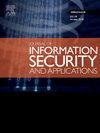将信息隐藏在具有(t, n)秘密共享的加密图像中,用于物联网和云服务
IF 3.7
2区 计算机科学
Q2 COMPUTER SCIENCE, INFORMATION SYSTEMS
Journal of Information Security and Applications
Pub Date : 2025-06-23
DOI:10.1016/j.jisa.2025.104137
引用次数: 0
摘要
随着信息技术的快速发展以及数据存储和云服务的指数级增长,隐私和安全问题已经出现。本文在物联网(IoT)和云服务的背景下解决了这些问题。针对加密图像中的可逆数据隐藏(rdhi)问题,提出了一种基于(t, n)秘密共享的创新方案,该方案使用可扩展的基于魔法矩阵的数据隐藏,提供了灵活的安全级别。该方案旨在通过秘密共享,将数据分成多个共享,有效分散风险,从而抵御黑客攻击。这确保泄漏少于t个共享不会危及整个数据,并提供灵活的参数方案。可扩展魔法矩阵的使用提高了嵌入容量和安全性,证明了所提出的RDHEI方案在数字时代保护数据的鲁棒性。此外,我们的方法在物联网网关而不是云服务器上对图像进行加密,使内容所有者能够断言所有权声明——这是以前的方案所不具备的能力。实验结果证实,我们的方案保持了高达4比特/像素(bpp)的恒定隐藏能力,同时保证了隐藏数据的机密性和生成共享的随机性。本文章由计算机程序翻译,如有差异,请以英文原文为准。
Hiding information in encrypted images with (t, n) secret sharing for IoT and cloud services
Privacy and security concerns have emerged with the rapid advancement of information technology and the exponential growth in data storage and cloud services. This paper addresses these issues in the context of the Internet of Things (IoT) and cloud services. Focusing on reversible data hiding in encrypted images (RDHEI), the study presents an innovative scheme based on (t, n) secret sharing using an expandable magic matrix-based data hiding, which offers flexible security levels. The scheme is designed to withstand hacker attacks by effectively dispersing risks through secret sharing, dividing the data into multiple shares. This ensures that leaking fewer than t shares does not compromise the entire data and provides a flexible parameter scheme. The use of the expandable magic matrix enhances both the embedding capacity and security, demonstrating the robustness of the proposed RDHEI scheme in protecting data in the digital age. Furthermore, our approach encrypts images at the IoT gateway rather than at the cloud server, enabling content owners to assert ownership claims—an ability not available in previous schemes. Experimental results confirm that our scheme maintains a constant concealment capacity of up to 4 bits per pixel (bpp), while safeguarding the confidentiality of the hidden data and preserving the randomness of the generated shares.
求助全文
通过发布文献求助,成功后即可免费获取论文全文。
去求助
来源期刊

Journal of Information Security and Applications
Computer Science-Computer Networks and Communications
CiteScore
10.90
自引率
5.40%
发文量
206
审稿时长
56 days
期刊介绍:
Journal of Information Security and Applications (JISA) focuses on the original research and practice-driven applications with relevance to information security and applications. JISA provides a common linkage between a vibrant scientific and research community and industry professionals by offering a clear view on modern problems and challenges in information security, as well as identifying promising scientific and "best-practice" solutions. JISA issues offer a balance between original research work and innovative industrial approaches by internationally renowned information security experts and researchers.
 求助内容:
求助内容: 应助结果提醒方式:
应助结果提醒方式:


